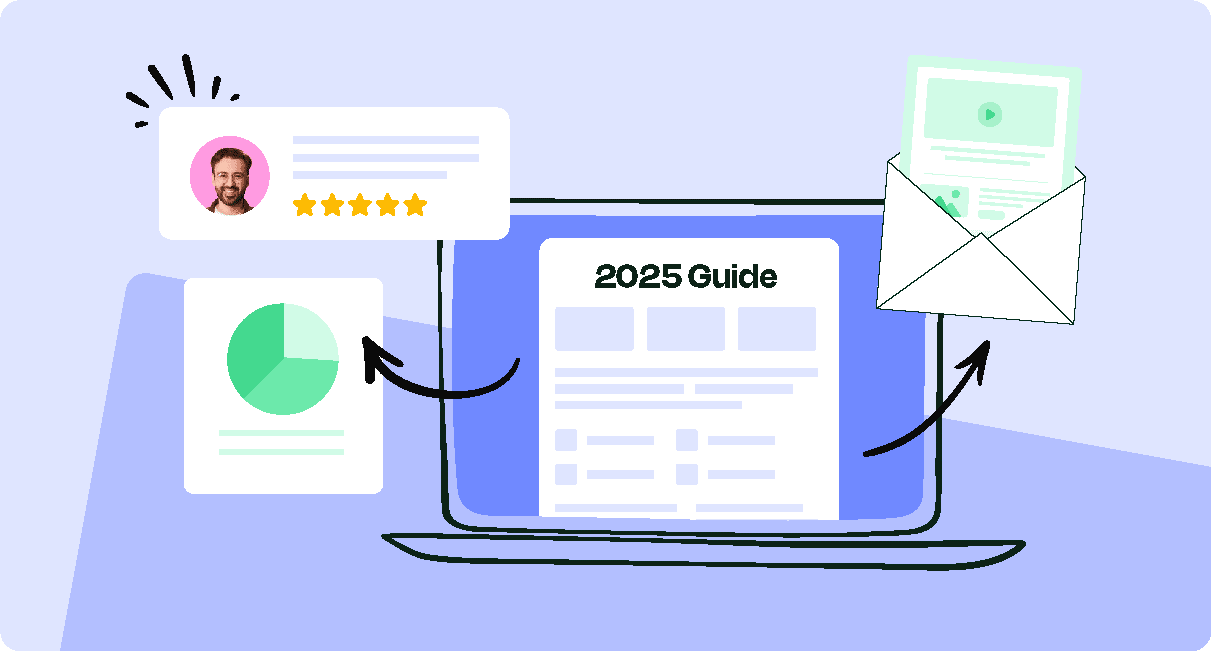Two-way communication is crucial for building trust among employees, aligning company goals, and sustaining productivity. But how can companies successfully incorporate this type of communication in a remote world? We get to the bottom of this.
Your business runs on communication, that much is certain. Messages are shared between staff, employers, clients, and dozens of stakeholders around the clock. But communication doesn’t always equal dialogue.
In fact, much of corporate communication consists of one-way messages, designed to impart information. In the meantime, many companies overlook the importance of two-way communication in the workplace. We’ll explore why this can be detrimental to your business, and how to improve two-way communication with a modern internal communications tool.
Book a demo and quickly see ContactMonkey’s internal communications solutions that help companies improve two-way communication with ease.
Take a self-guided tour of ContactMonkey
See how our key features can streamline your internal communications.
Take product tour

What is Two-Way Communication?
Two-way communication is the process of sharing information back and forth between two parties. In other words, it’s a conversation where both the sender and receiver invite and offer feedback. And most importantly, two-way communication is never a monologue.
To maximize the benefits of two-way communication in the workplace, dialogue should be continuous. In other words, the flow of information between the sender and the receiver should be consistent. Effective internal communications tools, methods, and channels are vital in facilitating this process.
ContactMonkey’s interactive employee engagement software helps to facilitate dialogue in the workplace. It differs from other workplace digital communications tools because it doesn’t simply send out information. It encourages conversations through employee pulse surveys, anonymous comments, a range of interactive elements. You can improve internal communication with emails that include interactive features.
Types of Two-Way Communication
Two-way communication doesn’t always mean instantaneous face-to-face (or these days, screen-to-screen) conversations. It also doesn’t exclusively involve dialogue between managers and subordinates. The latest innovative internal communications tools let you transform traditional communication channels into two-way messaging tools.
Here are just some of the ways that two-way communications can manifest in the workplace:
- Horizontal two-way communication: communication between employees of the same rank is known as horizontal two-way communication.
- Vertical two-way communication: this type of two-way communication takes place between a superior and their employees.
- Asynchronous two-way communication: dialogue isn’t all about face-to-face conversation. Including a question or survey in your asynchronous communications is a great way to initiate dialogue.
- Instantaneous two-way communication: this can include things like texting staff VIA employee SMS internal communications. If you choose to go this route, select a high-performance employee text messaging system and make sure to follow SMS content best practices.
Check out our blog on the importance of internal communication and learn how to get team buy-in for effective internal email tools.
Why is Two-Way Communication Important?
Two-way communication is important because it builds trust and helps improve the free flow of ideas in the workplace.
Consider the process of organizational innovation. Contrary to what many imagine, it’s not all about CEOs spawning brilliant ideas and passing them along to staff.
Instead, it’s about employees from all levels of the company sharing insights, getting feedback, and going back to the drawing board.
The same goes for problem-solving. If employees and managers don’t welcome creative criticism and new ideas, it becomes difficult to introduce new ways of thinking and doing. As such, companies end up using age-old solutions to tackle new problems, and finding themselves at a dead end.
When it comes to building trust, two-way communication helps employees feel comfortable sharing feedback with colleagues and leaders. As employees see that their input is welcomed and valued, they begin to open up more. In turn, more honest and authentic conversations begin to take place, which strengthens workplace relationships.
Start two-way conversations and employee feedback loops
Learn how to engage staff with pulse surveys, content ratings and reactions, custom polls, and more. Ready to send modern emails?
See engagement features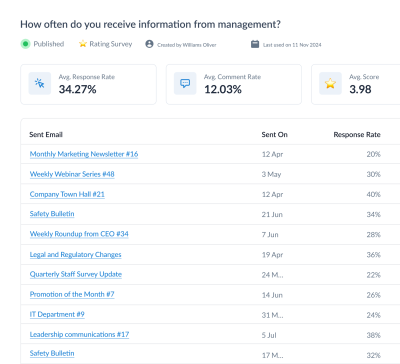
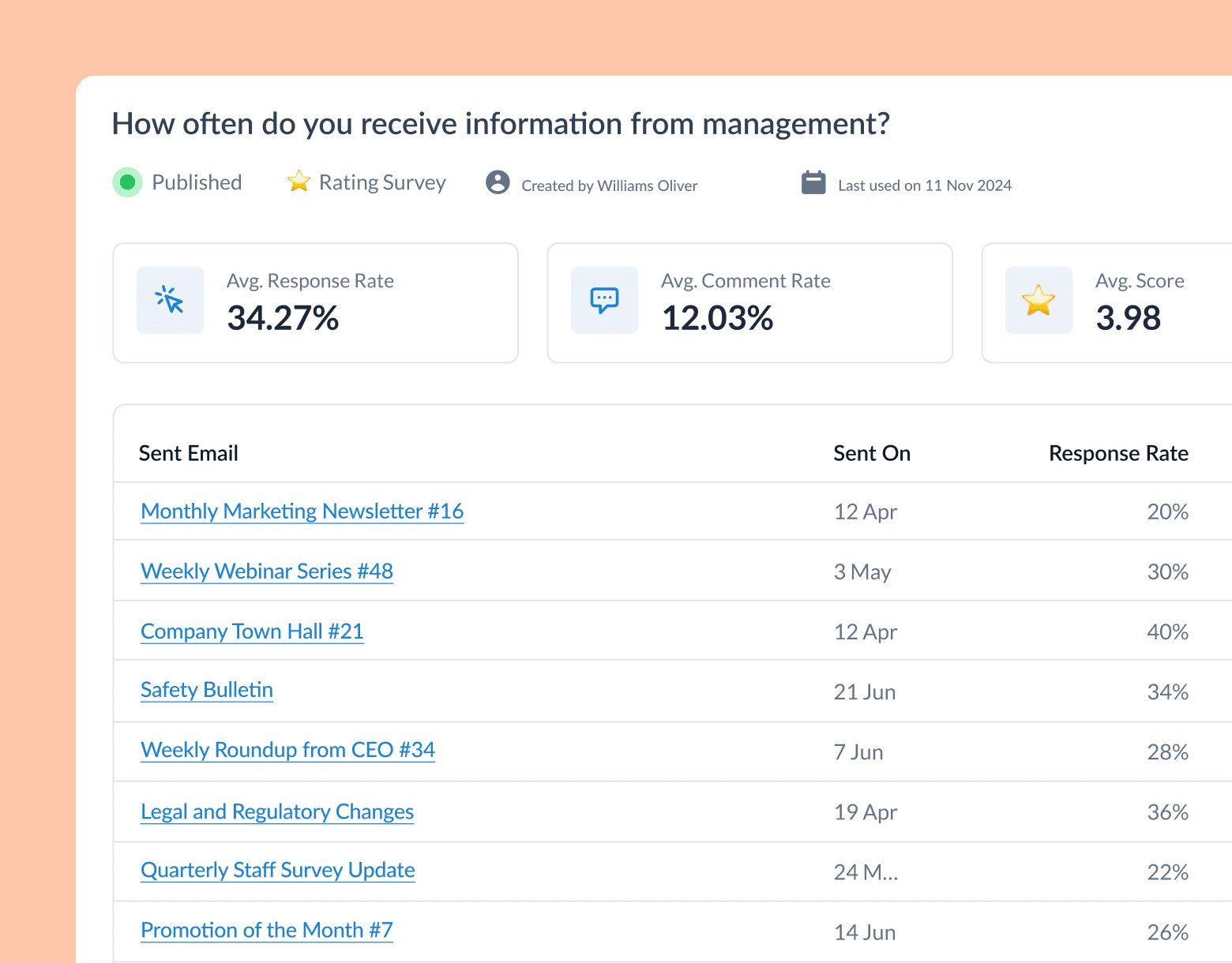
Benefits of Two-Way Communication
The main advantages of two-way communication is in building trust and enhancing communication systems by improving idea-sharing. But these assets lead to a range of indirect benefits as well. Here are just a few of the top ones to keep in mind:
- Greater mutual understanding: continuous two-way communication prevents misunderstandings and one-directional thinking.
- Improved team alignment and collaboration: when employees are used to back-and-forth communication it becomes harder to create siloes. Collaboration also becomes natural. Use internal collaboration software to make this happen.
- Increased employee engagement: when remote employees are consistently involved in cross-organizational dialogue, it prevents isolation and disconnection.
- Greater job satisfaction: two-way communication offers an outlet for employee concerns, ideas, opinions, leading to heightened employee satisfaction.
- Increased job productivity: consistent dialogue leads to less ambiguity about tasks, projects, and responsibilities. As a result, there are less obstacles to workflow.
- Improved trust between employees: two-way communication helps employees feel more comfortable, leads to honest and authentic feedback, and nurtures trust towards leaders.
Understand the link between workplace engagement and business success with our breakdown of the latest employee engagement statistics.
How to Encourage Two-Way Communication in the Workplace
Recognizing the benefits of two-way communication is important. But you may still be wondering “How do I actually implement this type of communication in the workplace?”
Don’t sweat it. Below, we cover some simple two-way communication best practices that you can easily incorporate into your internal messaging.
1. Picking the right communication channels
Two-way communication is only as effective as the channels and tools that you use to facilitate it. Take stock of your existing communication channels and identify the preferred methods of communication among employees.
Once you know what’s working, bolster your existing internal communication channels or implement new tools accordingly.
For instance, if employees are most vocal across Slack communities, start boosting two-way conversations through weekly surveys. If your newsletter garners a lot of engagement, use it to solicit more employee feedback, which can lead to new company newsletter ideas.
Pro tip: Use an interactive internal communications tool like ContactMonkey to improve two-way communication. ContactMonkey transforms static emails into dynamic conversations through comment boxes, videos, GIFs, and surveys in Outlook email and Gmail.
Choosing which employee you communicate with is important for gathering the feedback you need. With ContactMonkey, you can create custom internal email lists for different groups of employees with our List Management feature. ContactMonkey integrates with your Human Resources Information Systems (HRIS) like Workday and ADP, as well as Azure Active Directory, so your created email lists will be automatically updated as employees join and leave your company.
2. Creating a culture of employee feedback
To truly improve two-way communication, you’ll need to foster a culture of feedback in the workplace. After implementing the right feedback tools and channels, you should consistently gather employee input while encouraging upward feedback to managers.
Employee surveys and wellness check-ins should be conducted on a regular basis. In addition, leaders and managers should be encouraging feedback directly. This includes leaving time for Q&A during weekly stand ups and town halls.
Written leadership communications should also end with a question and offer more opportunities for feedback. For instance, you can add anonymous feedback boxes at the end of employee emails. This shows employees that their ideas and opinions are valued and encourages dialogue.
Use ContactMonkey’s pulse surveys to gather quick, continuous employee feedback. These types of employee surveys can be embedded directly into email newsletters and their short, simple format encourages more participation.


3. Showing empathy and transparency
You wouldn’t want to open up to someone who you know to be judgmental and critical. Neither do your employees. That’s why showcasing empathy, authenticity, and transparency across your communications is a key way to encourage dialogue
So how do you visibly demonstrate these qualities? For starters, pull back on corporate jargon and using language that conveys coolness or indifference. Instead, use more plain, simple language across your internal communications.
You can even add humour by inserting animated GIFs in emails or including fun employee survey questions. Comedy is disarming and can make your employees feel more comfortable sharing and engaging in two-way communication.
Add GIFs and embed videos into internal communications using ContactMonkey’s HTML email templates. Our responsive email template builder allows you to incorporate a range of multimedia directly into your employee emails.
4. Always acting on employee feedback
Acting on employee feedback is one of the most durable ways to encourage two-way communication. It shows your employees the value of their feedback and provides an incentive to speak up more often.
Say you’ve sent your employees a Slack message asking them for ideas on incentivizing customers to leave more reviews. You’ve gathered some great suggestions and plan to implement them into your Customer Success workflow.
The next step is to recognize the value of employee feedback and share how you plan to use it. In your next employee newsletter, add a quick appreciation message to your team and highlight how you’ll be utilizing their recommendations.
Not only is this incredibly simple to do, but it will incentivize employees to share their input in the long run.
Improve employee engagement and boost two-way communication by implementing one of our 20+ employee recognition ideas.
Examples of Two-Way Communication
Two-way communication is crucial when it comes to getting employees to weigh in on company decisions and ways to improve employee experience. Let’s look at some two-way communication examples to see practical ways to implement it in your organization.
1. Interactive employee newsletters
Interactive emails promote two-way communication by encouraging employees to engage with a range of different media. Unlike static emails, interactive newsletters invite employees to rate email content using stars and like buttons, respond with comments, and complete surveys.
With ContactMonkey’s interactive internal communications tool, users have access to all of these features alongside powerful internal email analytics. You can gather employee feedback, along with engagement metrics all in your ContactMonkey dashboard.
Learn how to improve your employee communications with compelling internal communications storytelling.
By tracking engagement, you can use data to improve your two-way communication strategy.
Unlock Internal Comms Superpowers
Discover why 10,000+ rely on us. See the internal email and employee newsletter platform in action.
Book demo

2. Employee pulse surveys and anonymous questionnaires
The short, focused nature of employee pulse surveys makes them easy to use on a frequent basis. By getting staff in the habit of sharing input and ideas, pulse surveys help make two-way communication feedback the norm across your organization.
Pulse surveys are normally positioned alongside other communications, like employee newsletters. This helps contextualize their topics.
For instance, if you want to find out whether employees are interested in more employee engagement opportunities, you can ask engagement questions next to an announcement about your upcoming virtual team building engagement games.
Anonymous feedback options also complement pulse surveys by giving employees the option to elaborate on their survey response:
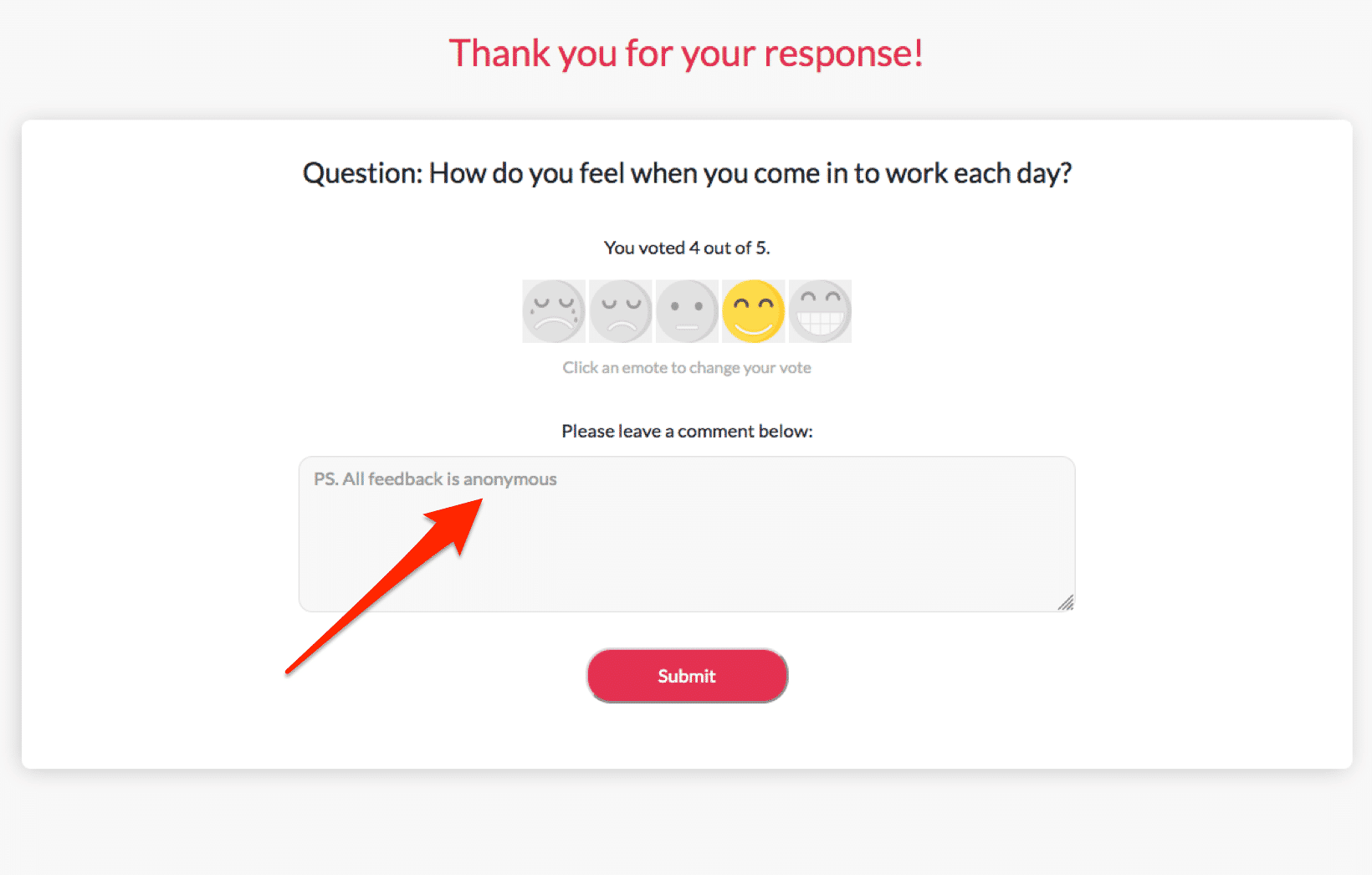
Whether you’re conducting employee exit surveys, company culture questionnaires, or employee engagement surveys, ContactMonkeylets you embed feedback options across your internal emails. Your company newsletters turn into a two-way employee engagement channel through emoji reactions, thumbs up/down, and a range of survey options.
Want to make beautiful newsletters faster? Learn how to create an employee newsletter that stands out with our step-by-step guide. Or if you’re looking to create newsletter content quickly, try using our OpenAI ChatGPT integration. Leveraging AI tools for corporate communications is a great way to try out different formats, create first drafts, and get ideas for your newsletter that can then be tweaked and customized for your audience.
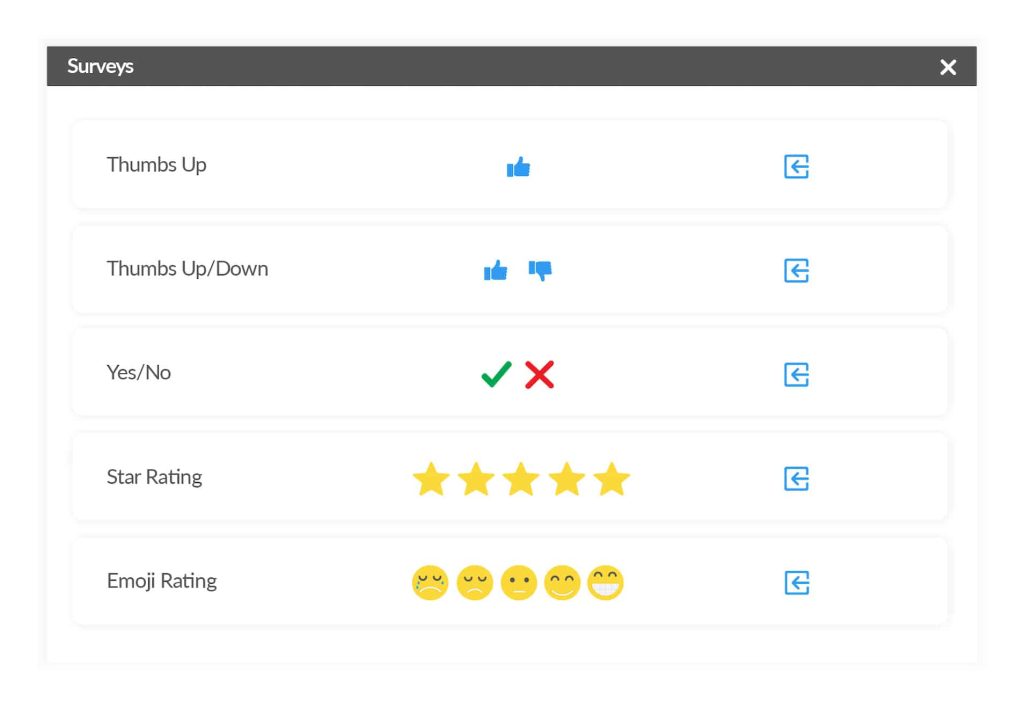
3. Virtual town halls
Virtual town halls are live stream events that bring together employees and leaders. It’s where managers provide key updates and employees have time to ask questions face-to-face. This makes virtual town halls a hub for two-way communication—if managed properly.
In addition to reserving time for Q&A sessions, you can conduct polls throughout your town hall to boost two-way communication. Employees can also be invited to give ‘shoutouts.’ This gives staff an opportunity to recognize fellow colleagues and improves two-way horizontal communication.
You can maximize two-way communication during your next town hall by following our complete virtual town hall meeting guide. To ensure that your town hall runs smoothly, we also recommend using ContactMonkey’s event management tool. It allows you to create, promote, and manage your virtual events straight from your internal newsletter.
4. Employee wellness check-ins
Wellness check-ins enable managers to assess a number of factors that impact employee wellbeing and engagement in the workplace. But they also facilitate two-way communication and encourage employers and managers to build trust.
Staff gain an outlet for sharing any challenges that they’re experiencing. They can also suggest resources that your company can provide to help.
Take a self-guided tour of ContactMonkey
See how our key features can streamline your internal communications.
Take product tour

Wellness check-ins can be done in-person during your weekly meetings with staff. They can also take on the form of two-way communication email campaigns. In the latter example, employee wellness surveys are sent out to employees in their newsletter.
Our guide on employee wellness surveys helps you learn how to lead successful employee wellness check-ins. It also shows you how to use them to promote two-way communication.
5. Employee Net Promoter Score (eNPS)
eNPS surveys are designed to check employee engagement levels across your organization. They do this by measuring the likelihood of your employees recommending your business to others as a place to work.
What makes them an effective two-way communication tool is their ability to tackle two priorities at once. While measuring employee engagement, eNPS surveys also invite employees to give feedback consistently through their simple, straightford structure:
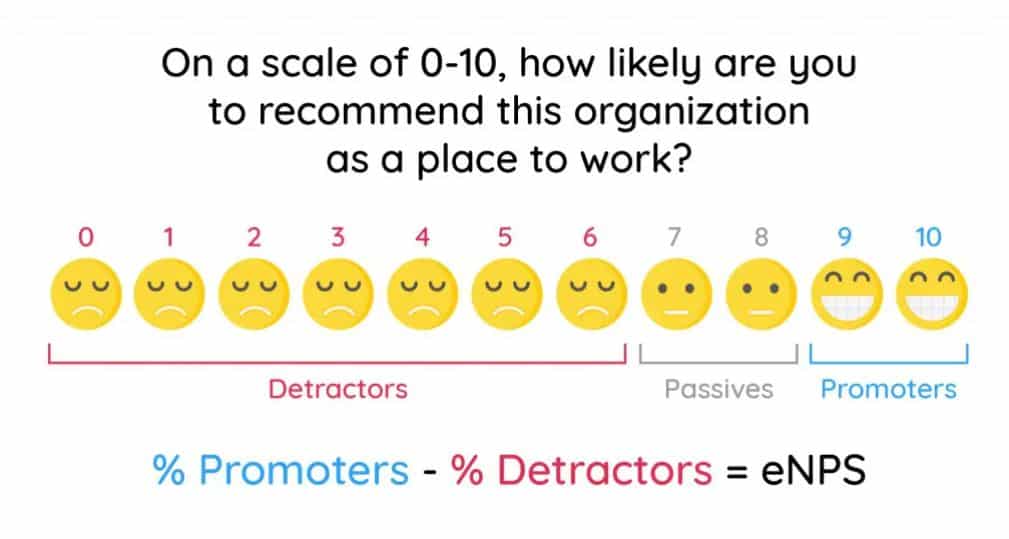
With ContactMonkey, you can track the results of your eNPS survey in your analytics dashboard. If you notice glaring issues with employee engagement, you can reach out to employees directly, asking for further feedback. In this way, eNPS surveys help promote continuous two-way communication.
Learn how to build a business case for internal communications campaigns, tools, and initiatives with our step-by-step guide.
Use Two-Way Communication to Drive Productivity
Two-way communication ensures that information moves in all directions across your organization. This maximizes collaboration and idea-sharing, promotes innovation, and boosts trust in leadership. But to get the most out of two-way communication you need to have tools designed to promote dialogue.
ContactMonkey doesn’t simply send out information. It helps you engage employees in conversation through interactive emails and embedded pulse surveys. Book your free demo to see ContactMonkey in action.



